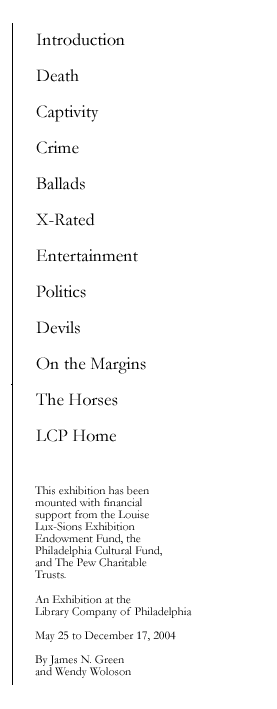

The most widely read books in early America were Bibles, almanacs, primers, sermons, political pamphlets, and government publications. Here are some examples. Books of this sort, however, are not the focus of the exhibition. Instead we have ransacked the Zinman Collection for disreputable books, books that were fun or sensational, and published writings of ordinary people or people at the margins of society.
Jonathan Mitchell. Nehemiah on the Wall in troublesom times … a Sermon preached at Boston [on] the Day of Election there. Cambridge: S. G[reen] and M. J[ohnson], 1671.
Some 4,500 sermons were printed in America before 1801, more imprints than any other genre, except government printing. (We have copies of half of them on our shelves.) Sermons were popular in the sense of being widely distributed and read, but they were dispensed by authority figures from the top down. Some of the earliest sermons printed were those preached on the day of the election of the General Court, thus combining civil with religious authority. This sermon was preached in 1667 but not printed until 1671; from then on, however, the election sermon was always printed immediately after it was delivered, usually at the expense of the government, and given away. Whether there was any popular demand for such sermons is an open question; the pristine condition of many copies suggests there was not.
The Farmers Almanack for the year 1714. Boston, 1714.
Nearly 3,000 different almanacs were printed in America before 1801, with edition sizes as high as 10,000 each. More people owned almanacs than any book except the Bible. Almanacs had the potential to be a truly popular cultural form, but they were scrutinized by the authorities for any sign of frivolity or subversion at least until the 1730s, when Franklin began to discover new ways to make his Poor Richard’s Almanack both useful and amusing. The almanac on display here is an important one: it is the first extant Farmer’s Almanack, a series that continues up to the present day; and the portrait of Queen Anne on the title page is the second woodcut portrait published in America.
The New-England Primer. Philadelphia: J. Crukshank, 1783.
The New-England Primer may have been the steadiest-selling single book in America before 1801. Nearly 150 editions are known in at least one example and many more were printed of which no copy survives. Benjamin Franklin’s firm printed 35,000 primers between 1749 and 1765, and only a single copy of each of two editions survives. Displayed here is a copy of a hitherto unknown edition. The alphabet cuts show clearly how authoritarian school books were in those days.
Thomas Paine. Common Sense. 10th ed. Providence: J. Carter, 1776.
The first American best-seller was Paine’s Common Sense. He claimed it sold 100,000 copies in 1776, a huge number for the time. The figure is at least plausible, considering that over 20 editions appeared in America and another 10 in Great Britain. Powerful men wrote most of the political pamphlets of the 18th century, whether they supported the existing government or wanted to replace it with one of their own party. Paine was different: he was a nobody, a radical recently arrived from England, and he was one of the first to advocate the total overthrow of the monarchy and its replacement with a new form of government of, by, and for the people. This was the most popular early American political pamphlet in every sense of the word “popular.”
Massachusetts. At a Council held in Boston January 8. 1679. The Council doth upon further Consideration judge meet to alter the day of Thanksgiving. [Boston: J. Foster, 1679].
In every colony printers were first brought in to work for civil and ecclesiastical authorities, and so the largest part of their output was government printing. At least 10,000 books and broadsides were printed for the governments of the colonies, the states, and the United States before 1801. This broadside from the Zinman Collection is the only copy known. The seal at the top is the first American woodcut.
The New Testament. Philadelphia: J. Crukshank, 1782.
The most commonly owned book in early America was the Bible, but all the English Bibles in the colonies were printed in Great Britain— or if they were American they were hiding behind false London imprints. This was partly because American printers honored the monopoly on Bibles granted to the King’s Printer, and partly because that monopoly allowed the British to produce Bibles that were cheaper and (just as important) more accurate than any American printer could manage. Even after Independence only one American edition of the Bible was published before 1790, though several editions of the smaller and cheaper New Testament did appear. This New Testament of 1782 is one of the earliest. It is the only copy known.
